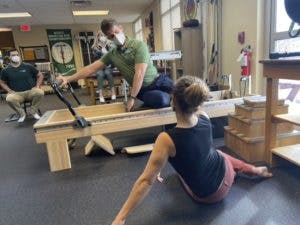By: Dr. Laura Wenger, PT, OCS, FAAOMPT
During this tumultuous past year, our clinic was fortunate enough to be able to go through with a planned remodel that included opening up our gym space (perfect timing in a world of physical distancing!) and updating our flooring. Along with updating our physical space, we have been able to update some of our equipment, as well! For those of you who have been patients of Tomsic PT in the past, you may have fond memories of the Shuttle machine. Now, in its place, we have a versatile clinical model of the Balanced Body Pilates Reformer, which has given us more ability to integrate Pilates exercises in our rehabilitation programs for many of our patients.
First, I’d like to explain a bit about what Pilates is. Names after its founder, Joseph Pilates, the exercise system created in the early 1900s is based on principles of core stability and strength through movement.(1) These exercises are performed on a spring-loaded machine, called a reformer, and there are also mat exercises that can be performed with no equipment necessary. Over the years, Pilates has evolved with many experts across the country teaching in Pilates studios, such as at one of the many esteemed studios that we have in our small town, as well as physical therapists and other health professionals integrating these exercises into the treatment of musculoskeletal problems from head to toe.


We are lucky here to have the guidance of one of our PTs, Christine, to share her knowledge of a wide variety of reformer exercises that she has learned through her previous training. We were able to take some time in early January to have a few intensive skills sessions within our group to learn and practice these exercises. As we’ve been integrating various exercises on the reformer into our patient care, our patients have been seeing great results with more mobility, more strength, more function, and less pain. These results are in line with research articles that demonstrate the positive effect of using Pilates exercises as a rehabilitation tool for reducing pain and disability, such as the 2018 systematic review by Byrnes et al.(2)


We are excited to continue to learn more about the use of the reformer as an effective part of a rehabilitation program as we continue to explore its use on ourselves and our patients. If you are curious about how Pilates exercises can be integrated into physical therapy for a musculoskeletal injury or post-operative care, make sure to contact our office to discuss this with one of our therapists!
1. Balanced Body. Origins. https://www.pilates.com/pilates/origins. 2018. Accessed Feb 9, 2021.
2. Byrnes K, We PJ, Whillier S. Is Pilates an effective rehabilitation tool? A systematic review. J Bodywork & Movement Therapies. 2018;22(1):192-202.

